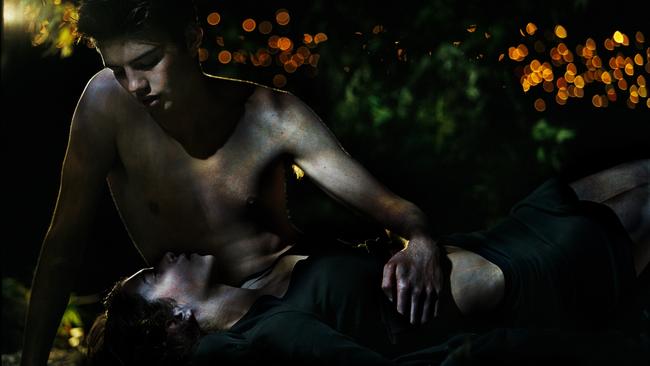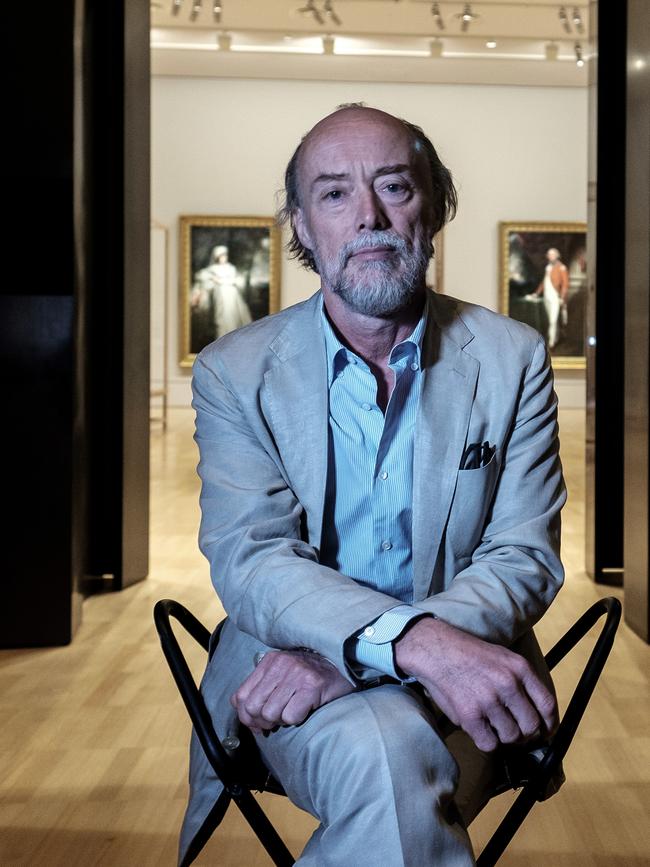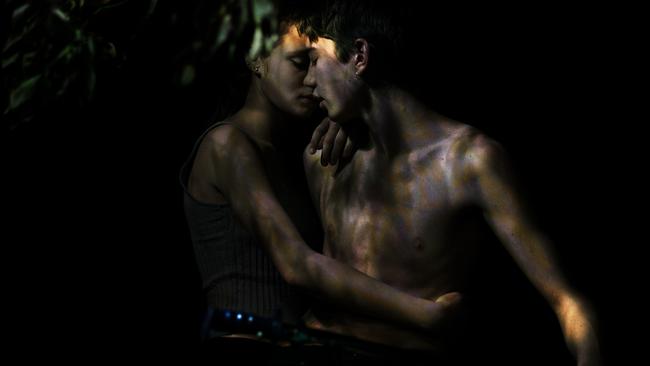Bill Henson at Robyn Oxley9 Gallery uncanny, familiar, dark
Bill Henson couldn’t work with models during COVID so instead he finished pictures that he tinkered with, though not to his satisfaction in the 1990s.

It’s a strange thing to think the world is limbering up for another Bill Henson opening. It will be where they always are at Roslyn Oxley’s gallery in Sydney’s Paddington, but, coming in the wake of the virus no one is sure can be conquered, there will be no audience.
This will be a weird opening for the photographer who ranks with the greatest painters this country has produced for his compositional majesty, his philosophical breadth and the stabbing power of his sense of drama — the patrons and the mates will all be gone, though the ghosts remain.
And that uncanniness is built into these works because if ever there was an exhibition that’s a search for time lost, a remembrance of things past, it’s this collection of pictures, of photographs from an artist who has pondered the images he parades almost off-handedly, from what might have been a lifetime ago.
A boy with the face of a slim adolescent that a nymph has stripped is half shadowed in mute wonder, his hand across a woman with eyes closed in sleep or death, his hand across her, his face pensive or sad. Highlights hit her cheekbones in profile as they do his slender frame. Does this Romeo sense that death has sucked the honey of his Juliet’s breath? We seem to be in a wasteland space or a graveyard, yet the lights behind him are the blur of some great boulevard, perhaps a spectral recognition of St Kilda Road, which Sidney Nolan as a boy believed was one of the great roads.
The boy in nothing but a stained T-shirt, head uplifted in a swoon of oblivion or overdose, tilts towards the woman, who faces the camera in murky chiaroscuro.
I have and haven’t been here before because these images come from that sequence of intensely dramatic images of a girl and a boy in some soiled and scarred place — all dark uncertainties of placing and driven erotic intensities that we recall from Henson’s work back in the 90s. And, yes, that’s precisely where they come from. In the time of COVID Bill Henson could hardly work with models and one of the things he’s done in this exhibition is bring to fulfilment, to actually finish pictures which he tinkered with, though not to his satisfaction decades ago.

I’ve known Bill Henson since we were both young in the 1980s. Someone told me and Michael Heyward, when we were editing literary magazine Scripsi, that the best photographer in Australia was teaching at the Victorian College of the Arts. We were the sorts of star-grabbers who published Helen Garner and Gerald Murnane along with Susan Sontag and Raymond Carver, so we thought if Henson was the best he was meant for us. It’s hard to forget the ravishing sense of distinction his work brought to the magazine when we published an anthology of his black-and-white Flinders Street railway station images of faces that might have stepped out of Giotto.
Because I’ve known him for so long and so continuously, Bill Henson still looks and sounds the same. The prominent blue eyes, the humorous voice that can encompass all the seriousness in the world to the point of obsession, the utterly consistent kindness. He muses about this exhibition that’s the realisation of recollections as well as the resolution of drafts and fragments from long ago.
“They’re all things shot 20 or more years ago,” he says, explaining patiently, painstakingly. “They’re images which were loved but never fully known or resolved. They sat there in the past with ticks and crosses, waiting for something. It’s as if they never knew how to finish themselves.”
So, I ask him, it’s not that he completed them and just happened to have them in his studio waiting for an appropriate time to exhibit them?
“No, there are pictures here where there has never been a print,” he says. “They have been done now from negatives and from proofs. But most of them were shot in 1997 and 1998 and what I’ve had to do is scan the negative when I have found what I want with the particular image.”
It’s a weird backward journey even for an artist like Henson who can be deeply recapitulative because he is also one of those artists who can seem to have sharply defined periods. And this makes it strange to be looking at figures from a new Henson show who are recognisable from a phase of his career that seemed long past.
Of course, we need a bit of a caveat to this sort of talk because you never meet the figures from Henson’s work even though you may have been in crowded rooms with his models, up close and laughing and drinking. One of the paradoxes with the girls in Henson’s pictures was that you met the models but not the figures. The girls in the pictures who seem to be overshadowed by the power of the Most High, like Mary’s in the face of an Annunciation, were never there to meet because they were creations of Henson’s imagination.
How could you, if you think about it? Ian McKellen once threw a hunk of cheese at my partner’s face, barking “Catch!”, and I’ve talked to him for hours on end but I never met his King Lear.
And, of course, Bill’s long-ago models with their lithe good looks and their natural expressiveness certainly offered their all to what Bill was trying to create, and they had a fierce loyalty to him.
In 2005 Bill Henson’s reputation was riding so high that he had at the Art Gallery of NSW the sort of retrospective that is normally reserved for the eminent dead. But, then, in 2008 a protest against an exhibition at Roslyn Oxley Gallery involved the prime minister of the day describing his images as “revolting” because some of them involved naked young girls. The images were seized by NSW Police. But there was no prosecution or charge and the images were returned.

Henson’s antagonists created more heat than light and he enjoyed the support of his models and such artistic figures as Cate Blanchett. He refused to buy into the debate or his own defence. Although he spoke in public about the nature of art he simply waited for the kerfuffle to die away, and it did.
His reputation is now as high as it has ever been.
So what of these adolescents from a previous century? “These people are now adults,” Henson says. “These pictures are much better than they would have been. They’re fresh, they’re real, they are not old prints. I feel like I’m right with these things. There’s much more in the picture than there would have been 20 years ago.” So it’s all a strange trajectory and you never feel with Henson that he’s simply making a virtue of necessity because if he does he makes such love to that employment that he makes it seem artistically necessary, not a makeshift thing.
Of course, there has always been with Henson a world of work between his different periods as his new and lustrous book, Sic Transit, testifies. (The title is an abbreviation of sic transit gloria mundi, so it passes the glory of the world.)
And it’s true that the mood and the brooding mystery of his latterday masterpieces, that sense of a recollection of “the dark and backward abysm of time”, to use Shakespeare’s phrase from The Tempest, works like an atmosphere in these pictures. He is aware that he’s anthologising a past that is going to look signposted. People will say they remember that model, they may be reminded of that magazine or book cover. Bill Henson also recalls the way some of these pictures connect with one of his earlier books of images, Lux et Nox, that panorama of light and dark.
“Yes, there’s Lux et Nox,” he says. “But I love these pictures. There’s a weight of intimacy in these things. There’s an intensity of imagery, which is a unique thing.”
And so we go back to these images that are at the same time examples of memento mori, apprehensions of death and new images from a master who has been playing on the same themes for all his long, exploratory career.
The girl seems to whisper in the image a secret on which the boy attends but cannot comprehend as he looks down in unknowing sorrow or haplessness. Her passion at this instant seems her only enigma, he is elsewhere. In the next image they seem to perform an erotic dance of slyness, eyes shut, as she has one arm around his waist and one hand on his shoulder in fragmented light and encircling darkness. In another picture his arm is to the left of the image, dislocated, an excrescence or a fetish.
The girl’s face is an enigma of quietude. Does she have him now or does she know he cannot be had? Is this heartbreaking poise self-possession? Is the thing she’s lost a new knowledge or a new woe? And then, in another picture, she stares in stage-lit half-profile, rocking him to sleep. Is this all there is, we ask. Is this the new heaven and the new Earth? The pose is traditional but the lighting with the bright spots of blue and indeed the gestures to the world create a sense of melancholy beyond words. But in yet another image, her hand is on his head, as she ponders the bare intimacy of his neck and he bows his head before her. The cropping of the picture, the mandala-like window it creates, has its own magic. The chiaroscuro is more studied now, more settled.
Life seems to mean business. But you can look on like another Judith in search of her Holofernes as much as a Juliet in search of her Romeo and they both can seem to stare apart at the sheer erotic mystery of nightlight.
Sometimes everything is almost abstract, an orange blur of impressionism merging into something else. And then there is the orange light that half-illuminates a tree where the rest of the world fades in blue-grey proximity.
What did TS Eliot say? “We know we have been there but we cannot say where.”
This is doubly true of Bill Henson’s new show because it seems to meditate on previous realisations of his vision. The man who produces all this is one of the more extraordinary people I have known. He is deeply in thrall to music and he will tell you why Kleiber’s is far and away the greatest interpretation of this and Celibidache of that. He can hold forth about the films of Visconti and he has special favourites among films, like the screwball Fellini film The Ship Sails On. He adores Network, the film about the news for which Peter Finch won an Oscar. And he is a passionate lover of books, which he collects like a fury. He adores the richness of that old rapscallion Norman Douglas but he is genuinely inward with all of Thomas Mann as well as the blackness — which he finds delicious — of a “mad” writer like the great Thomas Bernhardt or a quaint and precious writer like Robert Walser. He was an early admirer of Gerald Murnane and remains a devoted one.
All sorts of people swear by Bill Henson. Why? Partly because he is a deeply gentle man and partly because he is a great artist and his work is, God help us, full of grace and truth.
Bill Henson at Roslyn Oxley9 Gallery, from Friday, March 5, to April 3
